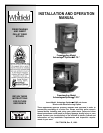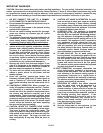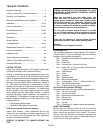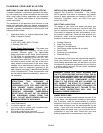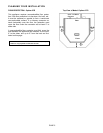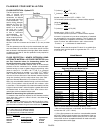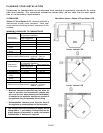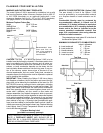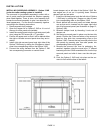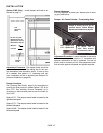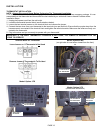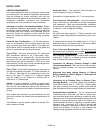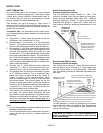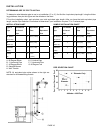
PLANNING YOUR INSTALLATION
PAGE 4
QUESTIONS TO ASK LOCAL BUILDING OFFICIAL
A correct installation is critical and imperative for reduc-
ing fire hazards and perilous conditions that can arise
when wood pellet burning appliances are improperly
installed. The installer must follow all of the manufac-
turers’ instructions.
The installation of this appliance must conform to local
codes and applicable state and federal requirements.
Familiarity with these requirements before installation is
essential. Important considerations to discuss with local
building officials include:
1. Applicable codes (i.e. Uniform Mechanical Code,
State or Regional Codes)?
Electrical codes:
In USA, NEC, ANSI / NFPA 70-2002.
In Canada, CSA C22.1
Power Supply Requirements
– The power cord
must be plugged into a standard, 115 volt, 60 Hz
grounded electrical outlet. The approximate
power requirement is 362 Watts, and will peak up
to 736 Watts for approximately 6 minutes when
the self-igniter is operating (it will turn off 2 min-
utes after flame detection). The power cord must
be routed to avoid contact with any of the hot or
sharp exterior surface areas of the stove. When
installed into a manufactured (mobile) home, the
appliance must be electrically grounded to the
steel chassis (see page 9, Manufactured [Mobile]
Home Requirements). These requirements must
be met unless otherwise specified by state or lo-
cal authorities.
WARNING: ELECTRICAL GROUNDING IN-
STRUCTIONS: THIS APPLIANCE IS
EQUIPPED WITH A THREE-PRONG
(GROUNDING) PLUG FOR YOUR PROTEC-
TION AGAINST SHOCK HAZARD AND
SHOULD BE PLUGGED DIRECTLY INTO A
PROPERLY GROUNDED THREE-PRONG
RECEPTACLE. DO NOT CUT OR REMOVE
THE GROUNDING PRONG FROM THIS
PLUG. DO NOT ROUTE POWER CORD UN-
DER OR IN FRONT OF APPLIANCE.
2. Local amendments?
3. Is a permit required - cost?
(you may wish to contact your insurance com-
pany to ask if they require this).
4. Is outside combustion air required?
5. Rooms where the installation is not allowed?
INSTALLATION / MAINTENANCE STANDARDS
National Fire Protection Association – The primary
NFPA standard that refers to installation and mainte-
nance of pellet appliances and venting is NFPA 211:
Chimneys, Fireplaces, Vents, and Solid Fuel appli-
ances, Jan. 2000.
SELECTING A LOCATION
The design of your home and where you place your
stove will determine its value as a source of heat. This
type of appliance depends primarily on air circulation
(convection) to disperse its heat, and therefore, a cen-
tral location is often best. There are other practical con-
siderations, which must be considered before a final
selection of locations is made.
♦ Existing Chimneys
♦ Pellet Fuel Storage
♦ Aesthetic Considerations
♦ Roof Design (rafter locations & roof pitch)
♦ Room Traffic
♦ Proximity to Combustibles
♦ Electrical Wiring
The installation of this stove will require some research.
Once your options are determined, consult with your
local building department who will be able to give you
the necessary installation requirements for your area (Is
a building permit required? Rooms where installation
may not be allowed, etc.).
WARNING: CHECK ALL LOCAL BUILDING AND
SAFETY CODES BEFORE INSTALLATION. THE IN-
STALLATION INSTRUCTIONS AND APPROPRIATE
CODE REQUIREMENTS MUST BE FOLLOWED EX-
ACTLY AND WITHOUT COMPROMISE. ALTERA-
TIONS TO THE STOVE ARE NOT ALLOWED. DO
NOT CONNECT THE STOVE TO A CHIMNEY SYS-
TEM SERVING ANOTHER STOVE, APPLIANCE, OR
ANY AIR DISTRIBUTION DUCT. FAILURE TO FOL-
LOW THESE INSTRUCTIONS WILL VOID THE
MANUFACTURERS WARRANTY.
SMOKE DETECTORS
Since there are always several potential sources of fire
in any home, we recommend installing smoke detec-
tors. If possible, install the smoke detector in a hallway
adjacent to the room (to reduce the possibility of occa-
sional false activation from the heat produced by the
stove). If your local code requires a smoke detector be
installed within the same room, you must follow the re-
quirements of your local code. Check with your local
building department for requirements in your area.



